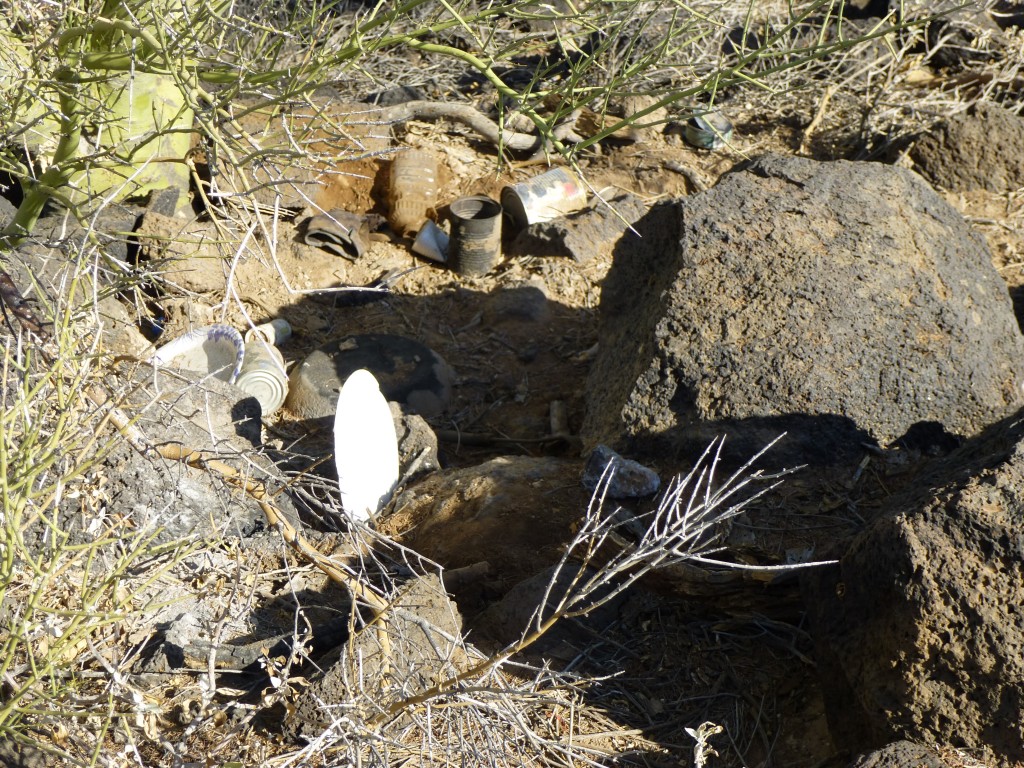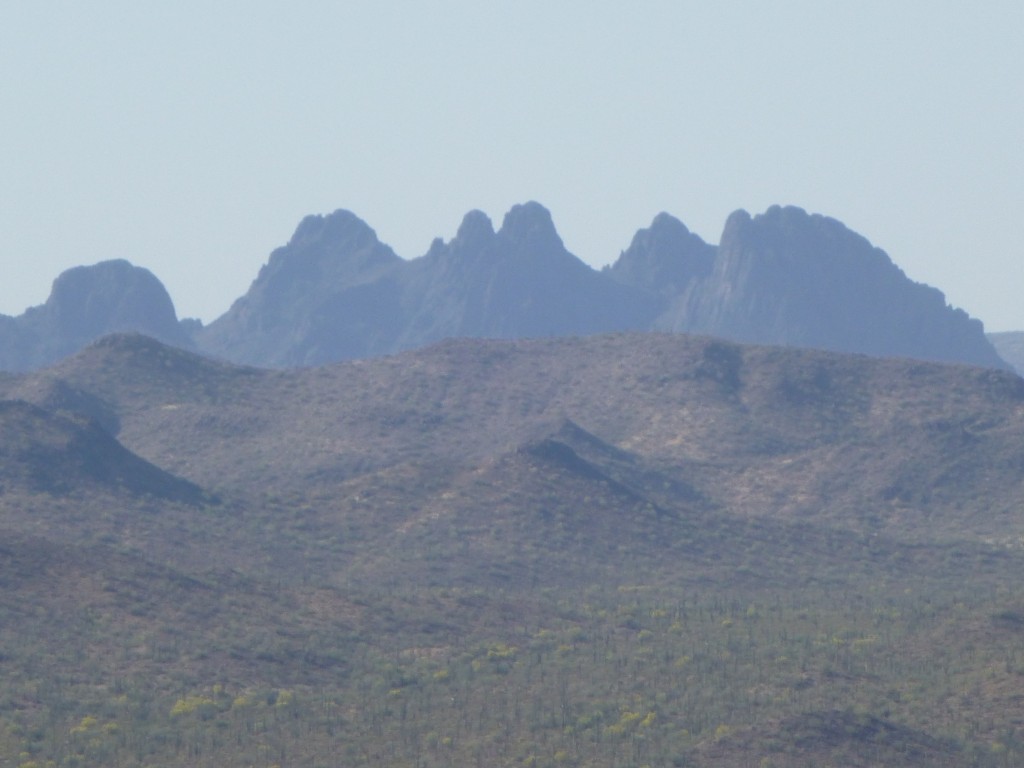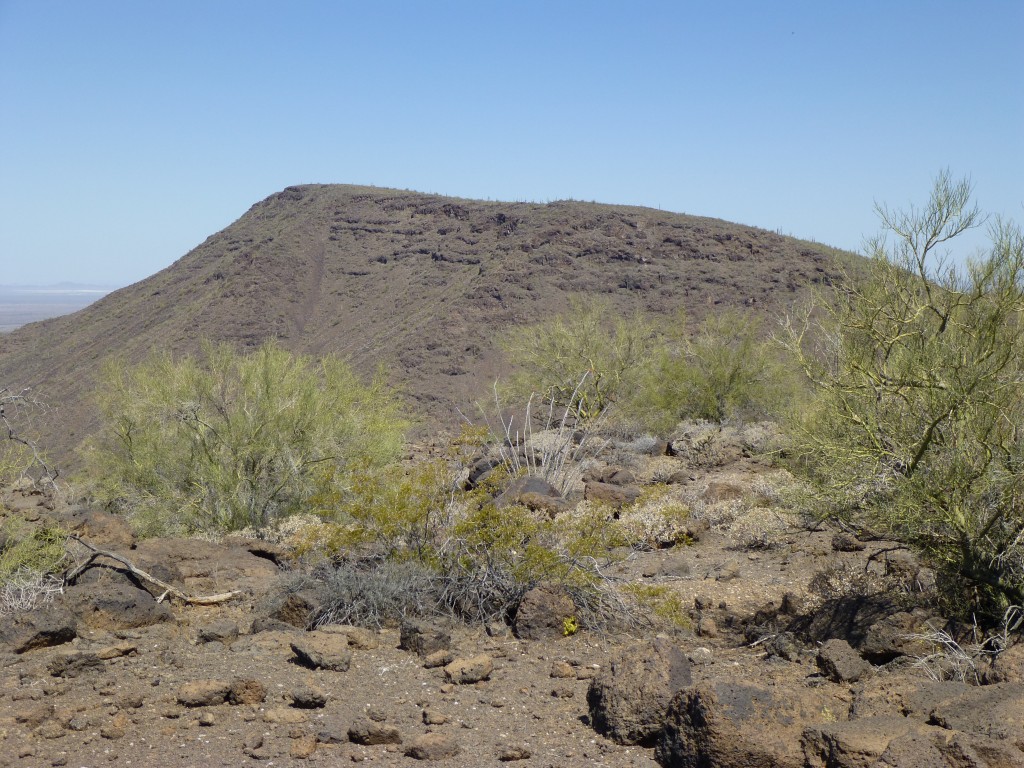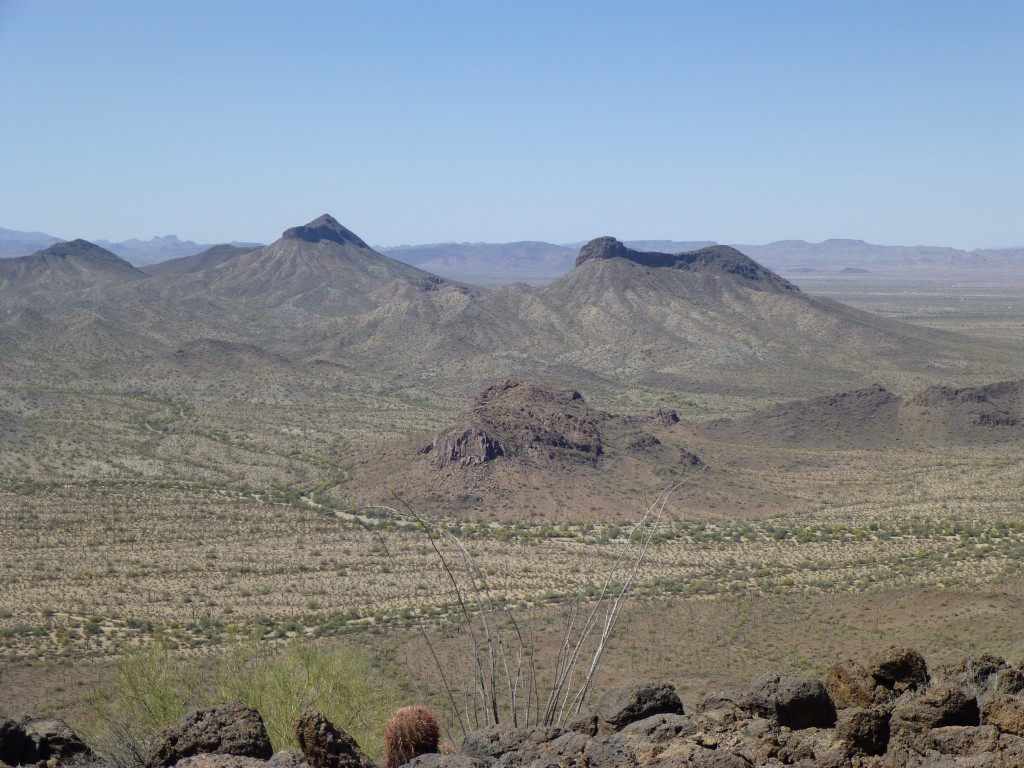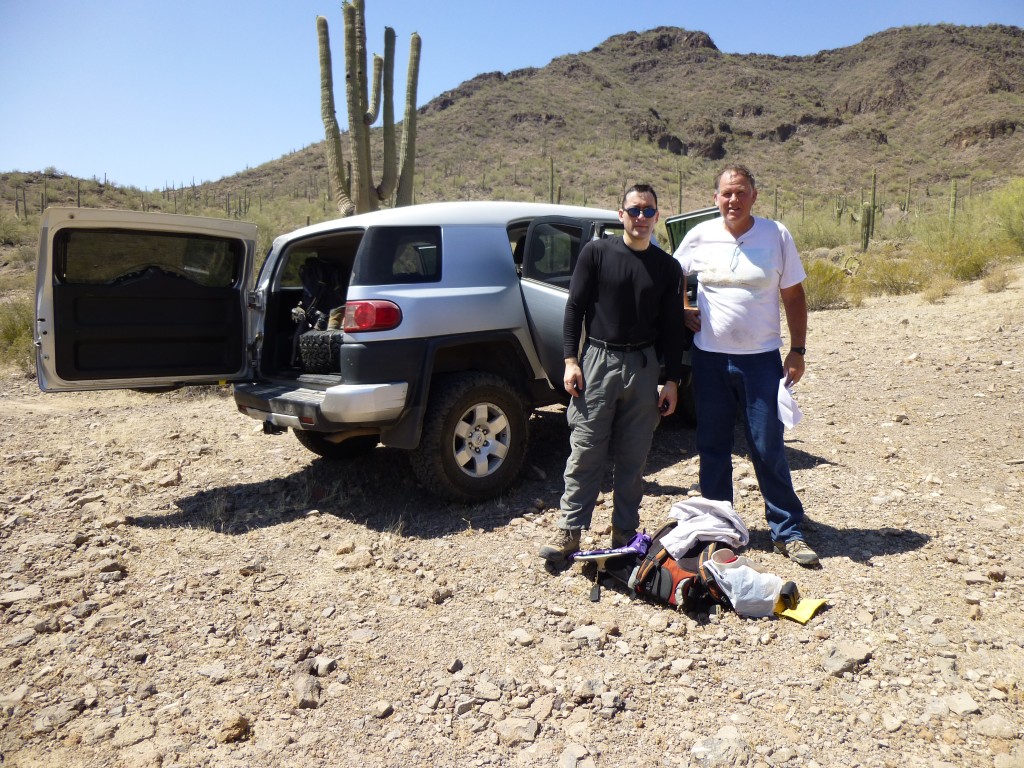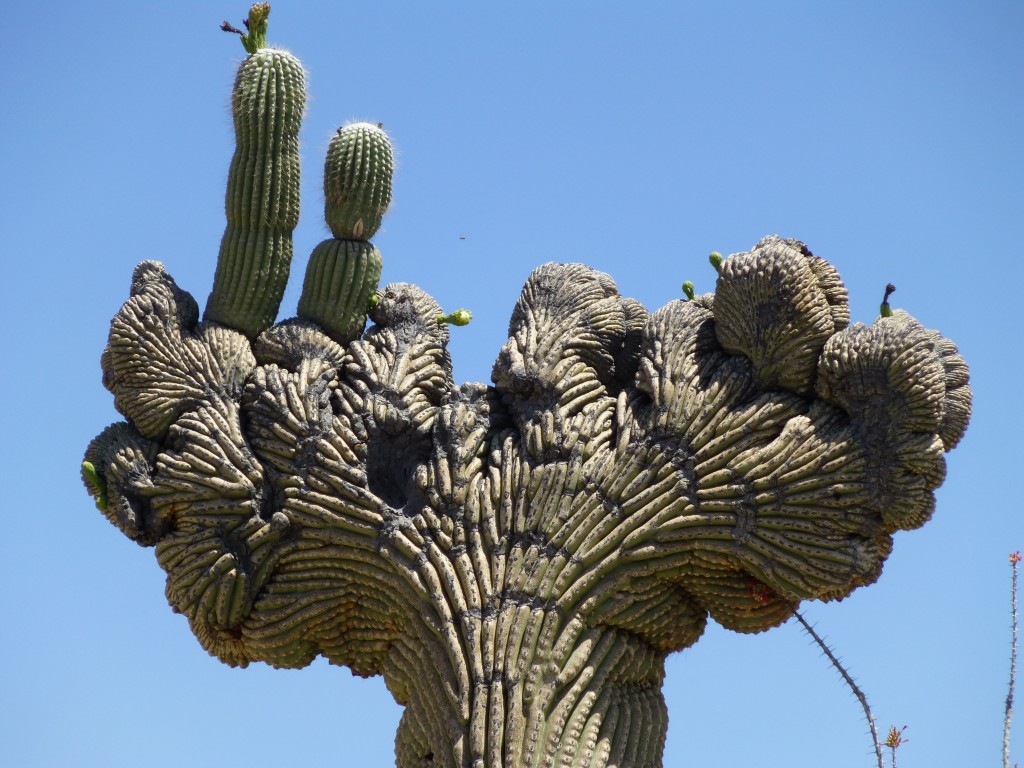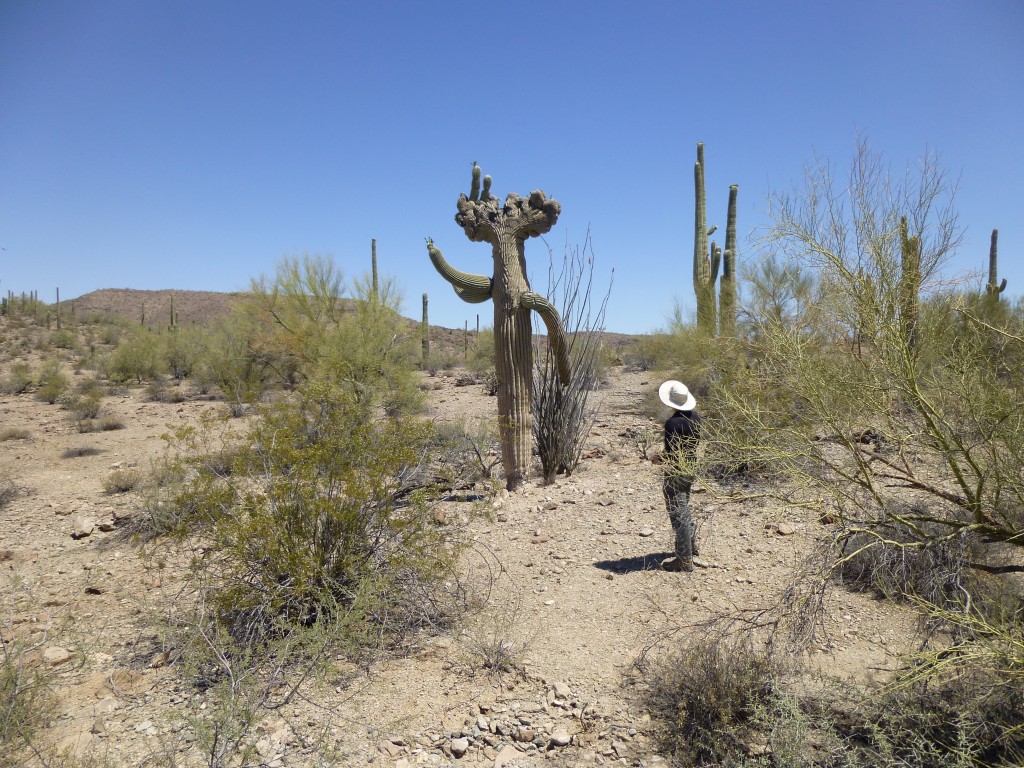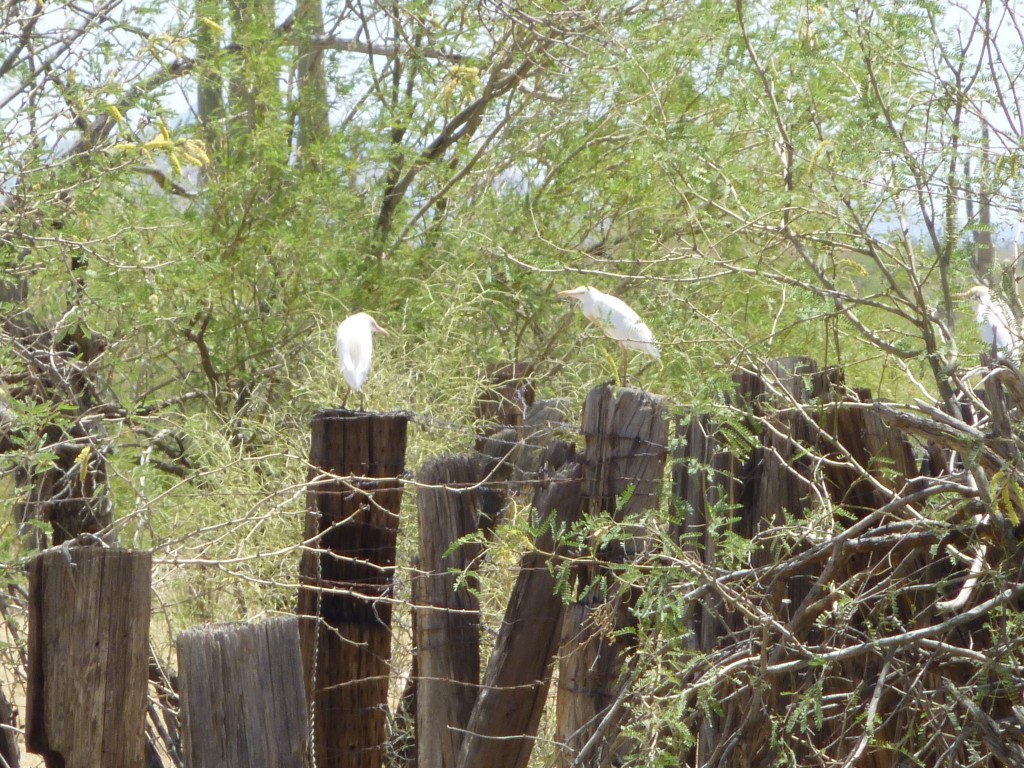At 4:30 in the morning, Andy Martin showed up at my place. It was mid-May, and we planned to head out to the Sand Tank Mountains for a day of climbing. By 6:00 a.m., we had pulled off the freeway at an abandoned building called Big Horn. Minutes later, our climber friend John Klein arrived in his four-wheel-drive vehicle and we all piled in. It doesn’t hurt that John is also a surgeon – if I ever fell down in the mountains and busted my head, he’s just the guy I’d want to be with.
It took us an hour and a half to drive the eleven miles of rough road, across the grain, deep into the heart of the range. I had different peaks to climb than John and Andy, so they dropped me off on the side of the road with all my stuff. Putting on my boots, I left my running shoes there and headed northeast across the desert to Round Butte. En route, I crossed the Sand Tank wash. The climb went without incident, and before long I stood on the summit. Others had been there before me, but there was no register to be found. However, the mountaintop was littered with the leavings of lookouts for human or drug trafficking, so much so that they had no doubt removed or destroyed the register. Some people have no respect!
Something else caught my eye. It was the image of a jagged peak to the southeast, a mere eleven miles away. It was the mighty Dragon’s Tooth, the unsullied prize of the Sand Tank Mountains. Here is a user’s guide to the 20x-telephoto picture below: the lower bump on the left skyline is a separate mountain, Peak 3300, still unclimbed; all of the other, higher points to the right are parts of Dragon’s Tooth. There are five main parts to DT: on the left is the east point; in the middle, close together are the two central points; to the right of them, farther back, is the southern outlier. The two central points make up one summit, the highest area of the entire DT. The east point is not a true summit, as it lacks the necessary 300 feet of relief. Both of the central points appear very technical in nature, and of those two, the western (or the one on the right) is the higher of the two.The fourth point over from the left, somewhat pyramidal in nature, is a southern outlier of the main central summit. Finally, the farthest point on the right is the western summit, which is a bit lower than the main summit in the center. It also appears technical. I probably have you totally confused by now.
Dragon’s Tooth has captivated me for years. I have seen it from every angle, and it never ceases to amaze. Today was no exception.
I decided to not leave a register on Round Butte – it would, sooner or later, only get destroyed by the illegals. It was so peaceful on top, a nice place to stay and enjoy the view, but I had to keep moving. Retracing my steps down to the desert floor, I soon was back where I had left my stuff. I put two more quarts of drink into my pack and set out walking northwest along a dirt road. In less than a mile, I had reached a saddle where I left the road and headed up the slope of my next mountain. It was straightforward, and, once on the highest ridge, I crossed two lesser bumps and stood on the summit of Peak 2575.
Here, I found a cairn and a summit register. Andy Bates had left it there in 2002. Four years later, Mark Nichols and Richard Joseph had also visited. Right next door was the much bigger peak known as Blue Plateau. Andy and John had come here today to climb it, and were somewhere up on its slopes.
Only a few miles away to the south were two more dandy peaks. Jack in the Pulpit is on the right, and Slag Benchmark is on the left.
I signed in to Andy’s register, put on my bushwhacking gloves, and started downslope. It was loose and slippery, so I took my sweet time. A drop of 800 vertical feet took me to where John’s vehicle was parked, and I arrived at the same time as they did. Here is a shot of the guys near the guzzler at the end of the road.
We loaded up our gear and headed back down the road. In a couple of miles, we came upon the site of the abandoned Papago Indian Chief mine. We had seen this on the map, so were curious about what we might find there. Maybe Andy more than John and I, because he is a renowned authority on old mining memorabilia, and, amazingly, he had never visited this mine. As we approached the site, something up on a hillside caught our collective eye.
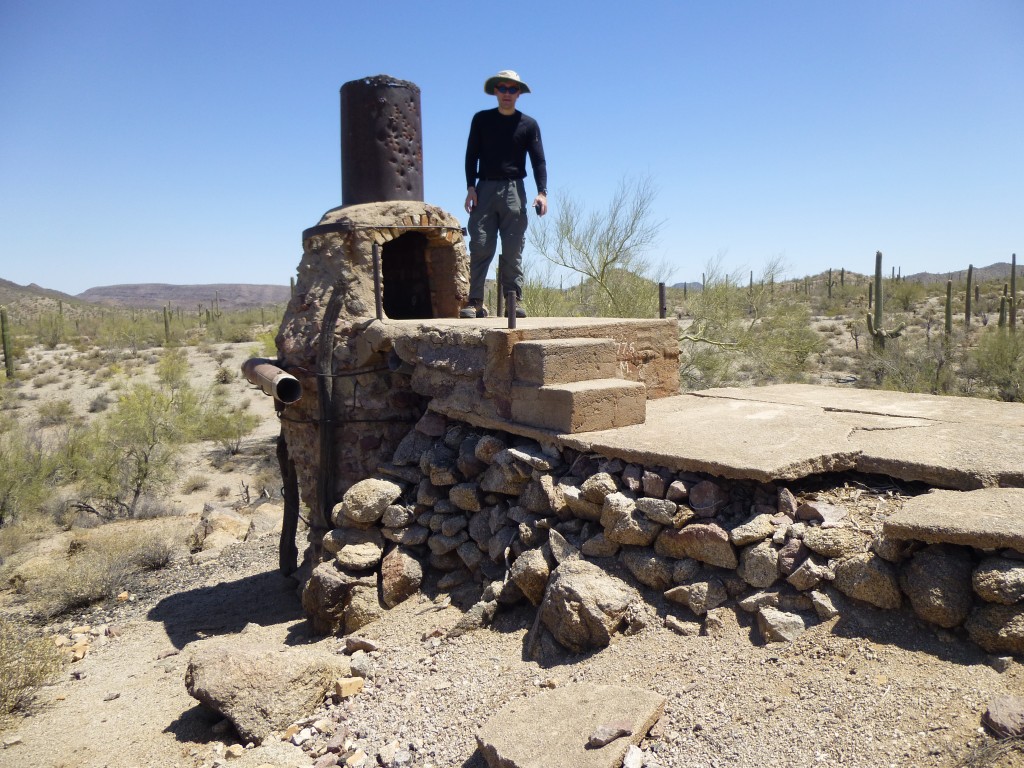 Upon closer inspection, it seemed like a crude smelter. Andy had spotted a small pile of slag nearby, which was the real clincher – he also said that to see such a thing at a small mine like this was highly unusual. Additional research shed more light on the mystery.
Upon closer inspection, it seemed like a crude smelter. Andy had spotted a small pile of slag nearby, which was the real clincher – he also said that to see such a thing at a small mine like this was highly unusual. Additional research shed more light on the mystery.
The mine and smelter were operated by Tom Childs, Jr. in the early 1900s and it is believed to have been abandoned sometime before the 1920s. Most mines in Arizona, particularly small mines such as this one, did not have their own smelter. All the ore was packed and hauled to a nearby smelter for processing. The Papago Chief’s copper ore was processed in place. Presently the smelter is in great shape and should be appreciated for its contribution to Arizona’s local history and a legally protected archaeological site. Tom Childs was a miner and cattleman who worked the local deserts from the late 1800s to the early 1900s. He was born in Yuma, AZ in 1870. Together with his father Tom Childs, Sr. they prospected and ranched in southern Arizona. In 1912 Tom Childs Sr. and Jr. sold their interest in a copper claim in Ajo to Calumet and Arizona Company. After some years of operation this company became part of the Phelps Dodge Corporation. The Childs would certainly be astonished to see Ajo today and what became of their claim. Tom married a local Tohono O’dham woman, and had twelve children. The most famous of his children, Fillman Childs Bell became an author and historian. Tom Childs served Arizona as a territorial and state legislator.
So, this old structure has been sitting there for a hundred years. It is remarkable how long things can survive in our hot, dry desert – the lack of moisture tends to mummify stuff. There was also a nearby mine shaft which we did not investigate. After a while, we left the site and started the irksome drive back out. En route, John spotted something that we had to stop and see. It was a rare cristate saguaro cactus. Scientists say that these occur only once in every 250,000 specimens. The reason for the mutation is not known for certain – it could be genetic, or even caused by freezing or a lightning strike. In any case, the growth point of the stem switches from a geometric point to a line, which folds and undulates as the crest expands. Here is what this beauty looked like:
Actually, this was the second one our party had encountered this day. We were in the midst of a veritable saguaro forest which extended to the horizon in every direction. Lucky find, for sure. John marked the location on his GPS for his scientist friend who was researching such things.
As we neared the freeway, we saw something odd – what appeared to be a very long line of 18-wheelers at a standstill. Earlier in the day, the guys had seen what looked like a column of black smoke to the north in the direction of this traffic jam. We never did find out what the problem was. Oh yes, I almost forgot – when we arrived back at Big Horn, we saw another unusual sight (for the desert) – egrets sitting on fence posts.
Fortunately, we were able to make it on to the freeway and continue home in the opposite direction of the tie-up. An hour later, Andy and I came upon another major incident on the interstate. A white SUV was badly mangled and laying on its side, its contents strewn about, and emergency vehicles all over the place. Once again, the traffic was in the opposite lanes and backed up for miles. Sadly, we later learned that a 24-year-old woman had perished in the accident when a rear tire blew and she lost control. Man, just goes to show you that every day is a gift, to be savored.
Please visit our Facebook page at https://www.facebook.com/pages/Desert-Mountaineer/192730747542690

